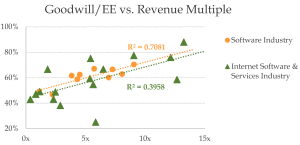Purchase accounting requires allocation of the purchase price among acquired assets on a fair value basis. The process is referred to as purchase price allocation (PPA) and it relies heavily on the valuation of acquired assets, mostly intangibles. PPA benchmarking is popular in assessing the reasonableness of any given PPA by comparing it with similar transactions.
We analyzed over 400 PPAs reported in 2015 by technology and life sciences companies. Beyond benchmarking, the purpose of the study was to understand how informative PPA benchmarking data can be for valuers, financial executives, and auditors.
A few takeaways are:
- Benchmarking can reveal industry-specific patterns in how goodwill and other intangible assets are recognized and valued.
- Benchmarking has to be sufficiently attuned to the specific characteristics of the type of business acquired.
- Substantial variability in PPAs persists regardless of sample size.
- Relationships may exist between a PPA and certain financial measures of the target.
Applicability of PPA Benchmarking
PPA benchmarking is a great way to gain useful information about the types of intangibles recognized, their relative valuations, and the amount of purchase consideration allocated to goodwill. In the table below, we compare technology, biopharmaceutical, and medical equipment PPAs. For example, one can observe the absence of customer relationships in biopharmaceutical acquisitions, or the greater amount of in-process R&D in medical equipment than in technology acquisitions.
Benchmarking must be based on a sufficiently large sample of comparable transactions
Even for similar acquired entities PPAs are expected to vary based on such factors as the acquirers’ M&A strategy or the subjectivity of valuation analyses. It may not be sufficient to rely on just a few comparable PPAs, especially because no two targets are identical. It’s also important to ensure that the sample PPAs adequately reflect the characteristics of the target; increasing the sample size will not compensate for a lack of comparability.
Below are comparisons between PPA benchmarking for the blended technology industry and for more narrowly defined industry segments such as software, IT consulting, internet, and electronic equipment.
Industry segmentation reveals certain trends that would otherwise remain hidden. For example, developed technology is dominant in software and almost absent in IT consulting acquisitions. And the importance of customer relationships in IT consulting or in-process R&D in electronic equipment acquisitions is obscured when seen from the too-broad viewpoint of blended technology industry PPA benchmarks.
Substantial variability in PPAs persists regardless of the sample size
PPA benchmarks are often based on medians of intangible/goodwill values measured as percentages of transaction sizes. We utilized excess consideration (defined as the summation of all intangibles including goodwill values) as a measure of the transaction size. In addition to median percentages, we calculated related standard deviations.
The table below summarizes the standard deviations of PPA benchmarks. It can be noted that standard deviations are significant in comparison to median percentages. Goodwill, likely due to its size, has the least amount of variability. The benchmarks are more reliable for customer relationships in IT consulting and electronic equipment PPAs, for developed technology in electronic equipment PPAs, or for trade names in IT consulting PPAs.
Less consistency is observed in software and internet PPAs despite the greater number of PPAs available. Further segmentation may be required to reveal more-relevant benchmarking data.
Relationships may exist between PPA and certain financial measures of the target
We attempted to identify correlations between financial measures and PPAs. Below is a chart showing correlations between goodwill as percentage of excess consideration and revenue multiples paid in each transaction. The strength of the observed correlations improved when specific industry segments were considered. Both internet and software segments demonstrated positive correlations between goodwill and valuation revenue multiples paid for acquired entities.
Because blended technology industry PPAs showed no discernable correlation between revenue multiples, we are hopeful that more carefully selected PPA sets would offer stronger relationships between financial measures and PPAs.






